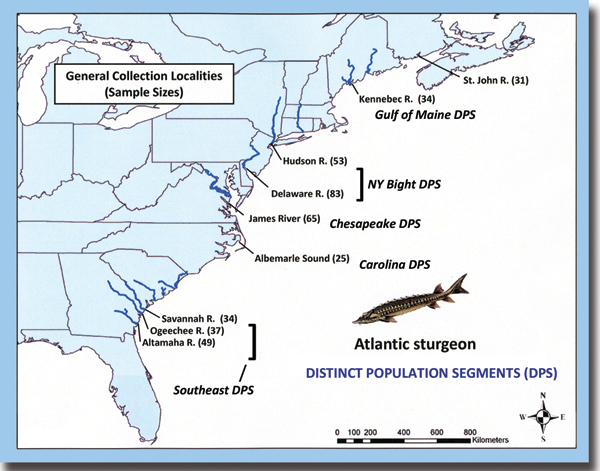The Atlantic Sturgeon (
Acipenser oxyrinchus), the ancient-looking fish covered with bony plates (scutes) rather than scales, was once abundant along the eastern seaboard and in major river systems from Labrador to Northern Florida. But human activities such as damming rivers, pollution and extensive harvesting have reduced the number and size of its populations and in February 2012, the Atlantic Sturgeon was federally listed as endangered.
The agencies that manage fisheries are concerned about preserving and restoring critical species. But to do this, they must first identify the distinct population segments or DPS of each species. Then managers can take into account any unique regional populations and preserve as much as possible natural genetic structure of each species in management and/or restoration plans. In the case of sturgeon, the DPS corresponds to the individual or combinations of estuaries along the eastern seaboard.
The key to this management strategy is genetic detective work—much of it done by pioneering researcher
Dr. Isaac Wirgin of New York University School of Medicine (aided by NYSG funding). The map of Atlantic sturgeon’s DPS was greatly dependent on Wirgin’s data identifying the genetic characteristics of each distinct population segment based on the estuary of origin.
Before doing genetic analysis on sturgeon, there was no way of knowing whether or not they showed homing fidelity. But Dr. Wirgin discovered that sturgeon do “go home again”; sturgeon can live in salt water but swim into the rivers and tributaries of their birth to spawn. Using biomarkers on mitochondrial DNA, Wirgin was able to identify DPS of sturgeon by distinct genetic characteristics. His lab can identify whether a sturgeon has come from the Hudson or the Chesapeake all from a tiny clip from the fish’s fin. In the 1990s, using such data, the National Marine Fisheries Service (NMFS) and the US Fish and Wildlife Service (FWS) listed the Gulf sturgeon as a threatened species, and reinforced the designation of the Gulf sturgeon as a distinct subspecies.
In 1998, because populations of the Atlantic sturgeon were so low, the Atlantic States Marine Fisheries Commission adopted a 40-year harvest moratorium. With the moratorium in place, the Atlantic sturgeon was considered a “species of concern” and not listed as endangered under the Endangered Species Act. In the years since, Wirgin has continually been analyzing sturgeon fin samples from different locations. The NOAA Observer Program which uses commercial boat observations out of Woods Hole, MA, sent Wirgin samples so he could identify the distinct population segments of origin of individual specimens from the Gulf of Maine to North Carolina. He and
Dr. Tim King of the U.S. Geological Survey found that some adult and subadult sturgeon from all populations undergo migrations and mix in coastal aggregations. This makes them vulnerable to distant anthropogenic impacts such as coastal bycatch (the topic of another NYSG-funded project). However, most fish tend to aggregate within the geographic region of their spawning river.
Based on work by Wirgin, King and others, a review team assessed the status of the Atlantic sturgeon, and determined that four of the five DPS of Atlantic sturgeon should be listed as endangered.
– Barbara A. Branca
